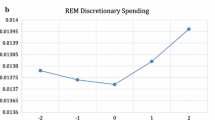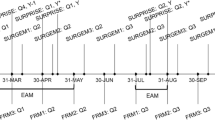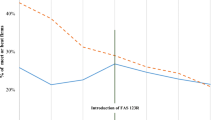Abstract
The joint hypotheses of informationally efficient markets, transparent financial statements, and adequate accounting disclosure suggest that announcements of changes in the accounting treatment of employee stock options from footnote disclosure to expense recognition should not trigger stock price reactions because free-cash-flows will not change. Event study results from a sample of 241 firms that announce such changes reveal statistically significant negative price changes followed by positive price changes about equal in magnitude. We propose the learning, sophisticated investor, neglected firm, and firm size hypotheses to explain the observed announcement-period stock price reaction.
Similar content being viewed by others
Notes
This ignores a potential signaling effect from the voluntary change that could cause a positive reaction in a world of asymmetric information (Aboody et al. 2004b). As Aboody et al. point out, expense recognition could be interpreted as a positive signal of the firm’s future prospects because the net income decrease negatively affects debt covenants and once a firm changes to recognition, it cannot change back to disclosure because recognition is FASB’s preferred method. However, Elayan et al. (2005) find no evidence that the post-announcement performance of announcing firms is better than matched non-announcing firms and dismiss a signaling effect.
What is crucial is the change in tax deductibility. The implication of the tax code is that changing accounting treatment would not change the firm’s taxes or the free-cash-flow of the firm. Therefore, absent signaling effects, there should not be a stock price reaction to the announcement under the joint hypotheses of informationally efficient markets and that current footnote disclosure provides sufficient information to investors.
Complete results are available from the corresponding author.
Results using Scholes-Williams beta estimates, GARCH and EGARCH models, and the CRSP EW index are similar and are available from the corresponding author.
Barry and Brown (1984) postulate that firms covered by fewer analysts have a higher probability that undisclosed material facts exist and Hong et al. (2000) report information on these firms diffuses more slowly. Therefore, differential reaction may occur in our sample firms. To examine the neglected firm effect, we extract the number of analysts that follow our sample firms one month prior to their event date from I/B/E/S and examine the highest and lowest quartiles of firms conditioned upon the number of analysts covering the firm. Results reveal no statistically significant reaction by either group, no statistical difference in the magnitude of the reaction between groups, and no statistical difference between the variances of the groups. Moreover, none of the CARs is statistically significant and no statistical difference between subsample reactions occurs. Thus, results do not provide support for the neglected firm hypothesis.
Part of the decrease in statistical significance arises from a decrease in statistical power due to the smaller sample size.
Results using the first and last quartiles are similar and are available from the corresponding author.
Event day -1 variability is 0.02272 for the early period compared to 0.02071 for the later period and day +1 variability is 0.03852 for the early period compared to 0.02650 for the later period.
The variability of the CARs for the first half /second half of event periods -1, 0, and +1 are 0.03247/0.02877, 0.04751/0.03692, and 0.04610/0.03332, respectively.
References
Abdul-Khalik A, McKeown J (1978) Understanding accounting changes in an efficient market: evidence of differential reaction. Account Rev 53(4):851–868 (October)
Aboody D, Barth ME, Kasznik R (2004a) SFAS No. 123 Stock-based compensation expense and equity market values. Account Rev 79:251–275
Aboody D, Barth ME, Kasznik R (2004b) Firms’ voluntary recognition of stock-based compensation expense. J Account Res 42:123–150
Accounting Principles Board (1972) Accounting for stock issued to employees, APB opinion No.25 (October) Norwalk, CT.
Akgiray V (1989) Conditional heteroskedasticity in time series of stock returns: evidence and forecasts. J Bus 62:55–80
Asness C (2004) Stock options and the lying liars who don’t want to expense them. Financ Anal J 60:9–14
Ball R (1972) Changes in accounting techniques and stock prices. J Account Res (Supplement) 10:1–38
Banz R (1981) The relationship between return and market value of common stocks. J Financ Econ 9:3–18
Barry C, Brown S (1984) Differential information and the small firm effect. J Financ Econ 13:283–294
Bartov E, Radakrishnan S, Krinsky I (2000) Investor sophistication and patterns in stock returns after earnings announcements. Account Rev 75:43–63
Battalio R, Mendenhall R (2003) Earnings expectations and investor clienteles. Working paper, University of Notre Dame
Beaver W (1981) Financial reporting: An accounting revolution. Prentice-Hall, Englewood Cliffs
Bell T, Landsman W, Miller B, Yeh S (2002) The valuation implications of employee stock option accounting for profitable computer software firms. Account Rev 77:971–996
Bhattacharya N, Black E, Christensen T, Mergenthaler R (2003) Who trades on pro forma earnings information? An intraday investigation of investor trading responses around pro forma press release dates. Working Paper, University of Utah, Brigham Young University, and PricewaterhouseCoopers
Boehmer E, Musumeci J, Poulsen A (1991) Event-study methodology under conditions of event-induced variance. J Financ Econ 30:253–272
Bollerslev T (1986) Generalized autoregressive conditional heteroskedasticity. J Econom 31:307–327
Bonner S, Walker P (1994) The effects of instruction and experience on the acquisition of auditing knowledge. Account Rev 69:157–178
Bonner S, Walther B, Young S (2003) Sophisticated and unsophisticated investors’ reactions to analysts’ forecast revisions conditional on factors that are associated with forecast accuracy. Account Rev 78:679–706
Bradshaw M, Bushee B, Miller G (2004) Accounting choice, home bias and U.S. investment in non-U.S. firms. J Account Res 42:795–841
Brennan M (1995) A perspective on accounting and stock prices. J Appl Corp Fin 8:43–52
Corrado C (1989) A nonparametric test for abnormal security-price performance in event studies. J Financ Econ 23:385–396
Cowan A (1992) Nonparametric event study tests. Rev Quant Financ Account 2:343–358
Dhaliwal D (1986) Measurement of financial leverage in the presence of unfunded pension obligations. Account Rev 61:651–661
Dimson E (1979) Risk measurement when shares are subject to infrequent trading. J Financ Econ 7:197–226
Dimson E, Marsh P (1986) Event study methodology and the size effect: the case of UK press recommendations. J Financ Econ 17:113–142
Elayan FA, Pukthuanthong K, Roll R (2005) Investors like firms that expense employee stock options and they dislike firms that fail to expense. Journal of Investment Management 3:75–98
Financial Accounting Standards Board (FASB) (1995) Financial Accounting Standard No.123, Accounting for Stock-Based Compensation, (October), Norwalk, CT.
Financial Accounting Standards Board (FASB) (2002) Financial Accounting Standard No.148, Accounting for Stock-Based Compensation-Transition and Disclosure, (December), Norwalk, CT.
Frederickson J, Miller J (2004) The effects of pro forma earnings disclosures and analysts’ and nonprofessional investors’ equity valuation judgments. Account Rev 79:667–686
Giaccotto C, Sfridis J (1996) Hypothesis testing in event studies: the case of variance changes. J Econ Bus 48:349–370
Grossman S, Miller M (1988) Liquidity and market structure. J Finance 43:617–633
Harrison W, Grudnitski G (1987) Bondholder and stockholder reactions to discretionary accounting changes. J Account Public Policy 6:87–113
Hirschleifer D, Teoh S (2002) Limited attention, information disclosure, and financial reporting. Working Paper, Ohio State University
Holthausen R (1981) Evidence on the effect of bond covenants and management compensation contracts on the choice of accounting techniques: the case of the depreciation switch-back. J Account Econ 3:73–109
Hong H, Lim T, Stein J (2000) Bad news travels slowly: size, analyst coverage, and the profitability of momentum strategies. J Finance 55:265–295
Huson M, Scott T, Weir H (2001) Earnings dilution and the explanatory power of earnings from returns. Account Rev 76:589–612
Lang M (2004) Employee stock options and equity valuation. Research Foundation of the CFA Institute, Charlottsville
Levene H (1960) Robust tests for the equality of variances. In: Olkin I, Ghurye SG, Hoefding W, Madow WG, Mann HB (eds) Contribution to probability and statistics. Stanford University Press, Palo Alto
Merton R (1987) A simple model of capital market equilibrium with incomplete information. J Finance 42:483–510
Nelson D (1990) Conditional heteroskedasticity in asset returns: a new approach. Econometrica 59:347–370
Rashes M (2001) Massively confused investors making conspicuously ignorant choices. J Finance 56:1911–1927
Reinganum M (1981) Misspecification of capital asset pricing: empirical anomalies based on earnings yield and market values. J Financ Econ 9:19–46
Sahlman W (2002) Expensing options solve nothing. Harvard Bus Rev 80:90–96
Scholes M, Williams J (1977) Estimating betas from nonsynchronous data. J Financ Econ 5:309–327
Slovic P (1969) Analyzing the expert judge: a descriptive study of a stockbroker’s decision processes. J Appl Psychol 53:255–293
Thomas W (1999) A test of the market’s mispricing of domestic and foreign earnings. J Account Econ 28:243–267
Walther B (1997) Investor sophistication and market earnings expectations. J Acc Res 35:157–179
White G, Sondhi A, Fried D (2003) The analysis and use of financial statements, 3rd edn. John Wiley & Sons Inc., Hoboken
Author information
Authors and Affiliations
Corresponding author
Appendix
Appendix
We use event-study methodology to determine announcement effects. If security returns follow a single-factor market model, returns can be expressed as
where R jt is the realized return of stock j on day t, R mt is the market return on day t; ɛ jt is a random variable that is homoskedastic, uncorrelated with R jt and R mt , and has an expected value of zero. β j measures the sensitivity of R jt to the market for stock j. The estimated coefficients are used to compute abnormal daily returns for the announcement period where event day +t (−t) represents the tth trading day after (before) the announcement date (t = 0). AR jt is the abnormal return of stock j on day t and measures the difference between the observed and expected daily returns. Formally, abnormal returns of stock j on day t are
where R jt is the realized return of stock j on day t, R mt is the market return on day t, and \(\hat \alpha _j \) and \(\hat \beta _j \) are the market model parameter estimates for stock j.
The average abnormal return (AAR t ) across announcing firms on day t is
where N is the number of firms (j) making announcements.
The cumulative average abnormal return (CAAR) between event day T 1 and day T 2 is
where T 1 and T 2 are the beginning and ending days of the event period, respectively.
Because abnormal returns are linearly related to beta, we use two methods of estimating betas. First, we utilize OLS regression to estimate coefficients and the estimate of the beta for security j is
where Cov j ,m is the covariance of the returns between security j and the market m.
Scholes and Williams (1977) show that errors in variables problems can occur with high-frequency (daily) data when OLS is used to estimate coefficients. However, consistent estimators can be computed as
and
where \(\hat \alpha _j \) is the Scholes-Williams OLS intercept estimator, \(\hat \beta _j^ - \) is the slope estimate from the OLS regression of R jt on R mt −1; \(\hat \beta _j^0 \) is the slope estimate from the OLS regression of R jt on R mt , \(\hat \beta _j^ + \) is the slope estimate from the OLS regression of R jt on R mt +1, and \(\hat \rho _m \) is the estimated first order autocorrelation of R m .
As another test of robustness, we use generalized autoregressive conditional heteroskedasticity (GARCH) and exponential generalized autoregressive conditional heteroskedasticity (EGARCH) models. With GARCH and EGARCH models, returns continue to follow the form \(R_{jt} = \alpha _j + \beta _j R_{mt} + \varepsilon _{jt,} \). However, they differ in the assumption of the behavior of the error term. In GARCH and EGARCH, \(\left. {\varepsilon _{jt} } \right|\Psi _{t - 1} \sim \left( {0,h_{jt} } \right)\) and Ψ denotes all information available at time t − 1. Using maximum likelihood to estimate the parameters, the conditional variance for the GARCH model is \(h_{jt} = \omega _j \;\delta _j \;h_{jt - 1} + \gamma _j \;\varepsilon _{jt - 1}^2 \) with ω j > 0, γ j > 0, δ j ≥ 0, and γ j + δ j < 1 and the conditional variance for the EGARCH model is where
Boehmer et al. (1991) report that if an event causes event-induced variance, commonly used tests reject the null hypothesis too frequently. Their corrected test requires the residuals to be standardized by the estimation period standard deviation before using the ordinary cross-sectional technique.
Formally, the standardized cross-sectional test statistic, Z t , is
where TSAR t is the average event-period standardized residual for event day t, N is the number of firms in the sample, and √(N × SSAR ·t ) is the contemporaneous cross-sectional standard error. TSAR t is
where SAR jt is the standardized error for firm j on day t.
\(S_{{\text{SAR}}_{ \cdot {\text{t}}} }^{\text{2}} \) is
The standardized cumulative abnormal, SCAR, return for stock j is
and \(s_{{\text{CAR}}_{T1j,t2j} } \) is
where \(S_{A_j }^2 \) is
D j is the number of trading day returns in the D-day interval, \(T_{D_b } \) through \(T_{D_e } \), that are utilized to estimate firm j’s parameters. L j is length of the trading-day event period and \(\bar R_m \) is the average market return over the estimation period.
The standardized cross-sectional test statistic is
where
To enhance the robustness of our results, we use several nonparametric tests to confirm parametric results. The generalized sign Z-test examines the number of securities with positive and negative average abnormal returns during estimation and event periods under the null hypothesis that the fraction of positive returns during the event period is the same as the fraction of positive returns during the estimation period. The fraction of positive returns under the null hypothesis is
and the test statistic is
Corrado (1989) developed the rank Z-test that treats the combined estimation period and event period as a single set of returns and assigns a rank to each daily return for each firm. K jt represents the rank of abnormal return of stock j during the combined estimation and event period, D j + E j , respectively. The average rank across the combined estimation and event period is
The rank Z-test statistic for days T 1 through T 2 is
where
The jackknife Z-test introduced by Giaccotto and Sfridis (1996) incorporates the standardized abnormal return for each stock j, using the event period sample standard deviation. The standardized abnormal return of day t is
where
and \(\overline {A_j } \) is the event period, \(E = T_e - T_b + {\text{1}}\) days, mean abnormal return of stock j. If an event-induced, transient variance change on event day t occurs, \(\tilde \sigma _{A_{jt} } \) and \(\hat \theta \) become biased. The procedure for reducing the bias is to jackknife the \(\hat \theta \) values. To perform the jackknife, we first sequentially delete one abnormal return A jTs from Eq. 23 and re-compute \(\tilde \sigma _{A_{jt} } \), using the new value to re-compute \(\hat \theta \) using Eq. 22. We define the latter value \(\hat \theta _{\left( { - s} \right)} \) and form pseudo-values
The jackknife estimator for stock j on day t is the mean of the pseudo-values
Then, we average the estimates across the sample of stocks to gain efficiency
and the jackknife Z-test statistic for the sample of stocks on day t is
where
The distribution of t Jackknife under the null hypothesis is approximately normal with mean zero and unit variance.
To test the significance of the cumulative average abnormal return over date T 1 through date T 2, define
Sequentially we delete one abnormal return A jTs from Eq. 22 and re-compute \(\tilde \sigma _{A_{jt} } \), using the new value in turn to re-compute \(\hat \theta \) using Eq. 28. Now, define the latter value \(\hat \theta _{\left( { - s} \right),T_1 ,T_2 } \) and form pseudo-values
The jackknife estimator for stock j during the period (T 1, T 2) is the average of the pseudo-values
We average the estimates across the sample of stocks,
and the jackknife test statistic is
where
Rights and permissions
About this article
Cite this article
Prather, L.J., Chu, TH. & Bayes, P.E. Market reactions to announcements to expense options. J Econ Finance 33, 223–245 (2009). https://doi.org/10.1007/s12197-008-9035-5
Published:
Issue Date:
DOI: https://doi.org/10.1007/s12197-008-9035-5




